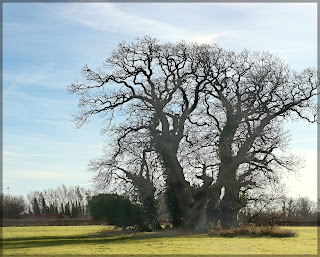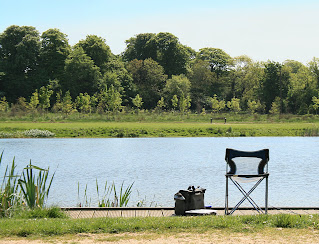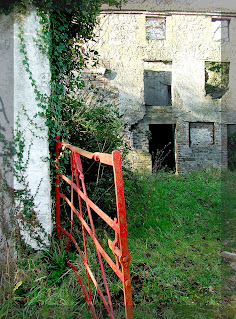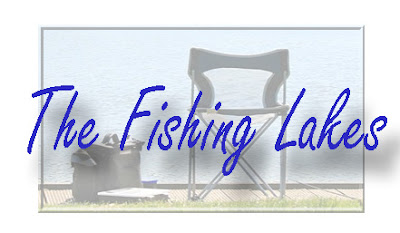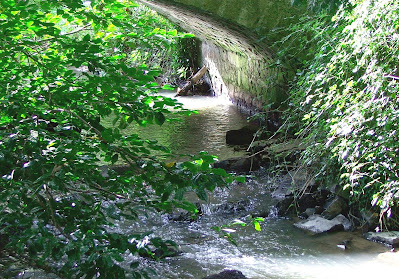Corkagh Park
Corkagh Park spans over 150 acres between the Naas Road and historic Clondalkin Village. The park incorporates the lands of Corkagh House which was demolished in the early 1960s leaving only the stables and outbuildings visible today. The estate was bought by Dublin County Council in 1983 and opened as a public park in 1986. Corkagh has a long and interesting history with much to discover as you wander its paths and tracks.
The name Corkagh comes from the Irish word for marshy land and indeed areas of the park near the Camac have a tendency to become waterlogged during wet periods. The river Camac which rises SE of Saggart flows through the park towards Clondalkin village, then on through Inchicore and Kilmainham before entering the Liffey near Heuston Station.
While the Camac seems little more than a stream most of the time it has been known to become a raging torrent after heavy rain.
There have been many mills built along the Camac over the centuries including two at Corkagh: The Gunpowder Mills (a mill pond, millrace, and mill ruin can be seen next to the fishing lakes) which operated throughout the 18th century, and Fairview Oil Mills (located at the Cherrywood pedestrian entrance) a 19th century building now in ruins .
 |
| Flooding at Corkagh |
Corkagh once formed part of the lands associated with the monastery at Clondalkin which was founded by St Mochua in the 7th century. These lands would have been granted to him by the local ruling chieftain. Corkagh remained in church ownership until about 1600.
In 1703 Corkagh was purchased by Lewis Chaigneau, a successful wine merchant of French Huguenot descent. He built a fine house next to an older farmhouse dating from approximately 1690. The older building was retained for use as kitchens and staff quarters.
The house and lands were purchased by the Finlay family in the mid 18th century and their descendants continued as owners until 1959. It is the Finlay family who designed the basic layout of the demesne as we see it today.
Corkagh was sold to an Australian millionaire, John Galvin, in 1959 and the Finlay/Colley family moved to Kilmatead which is located next to the park. The new owner renamed the estate Treemare Stud and founded one of the first riding schools in Ireland here. Galvin was interested in equestrian sports and many famous horses were stabled and trained at Corkagh. He also raised prize cattle and as a result large areas of mature trees were removed to provide grazing land. It was Galvin who inexplicably demolished the fine old Corkagh house in the early 60s.
Today all that remains of Corkagh House are the stables, cottages and outbuildings which lay behind the main building. During the heyday of Corkagh House the estate buildings were alive with the noise of servants and farm labourers going about their daily duties. Mostly dating to the early 1800s, the buildings served various functions including laundries, dairies, grain storage and animal housing. They are now used as a depot by the Parks Department.
When Lewis Chaigneau purchased Corkagh in the early 18th century he leased the south-western portion of the estate to another Huguenot family, the Greubers, to develop as a Gunpowder Mill
and building was complete by 1720. Most of the mill buildings were located in the area next to Corkagh now known as Kilmatead however a ruined mill building,
millpond and mill race can still be seen near the fishing lakes.
The Arboretum is a favourite place to picnic at Corkagh. Surrounded by mature trees it always feels sheltered. It has been planted with trees from the continents that the Irish emigrated to following the Potato famine of the 1840s. The Arboretum has served other interesting
functions over the decades:
A circuit for motor racing in the 1940s (Dudley Colley, who owned Corkagh at the time was a motor enthusiast) and a show jumping ring where Olympic champions trained in the 1960s during the Treemare Stud era.
If you enter the park from the Naas Road end you will walk along a path known as Oak Avenue which was once the main approach to Corkagh House. There was a gate lodge here but it was demolished during widening of the Naas Road. The avenue was named for the Oaks which lined it.
Some of those Oaks, now more than 200 years old, survive and the council have planted new Oaks alongside. This path was known to be haunted by the ghost of Lord Kilwarden.
Kilwarden lived at nearby Newlands House and was ambushed in Thomas Street and murdered by Irish revolutionaries in 1803. His horses took fright and galloped back towards Clondalkin
with the empty carriage. They entered by the St Johns Road gate and turned up Oak Avenue towards Newlands. It is said that the sounds of ghostly galloping can still be heard from time to time.
On one side of Oak Avenue, near the Naas Road car park, is the new cycle track and you may notice some ancient gnarled trees at the centre. This is all that is left of a wooded area marked on 19th century maps as The Foxes Covert.
A Foxes Covert (pronounced cover) is an area of woodland or scrub where a fox is known to hide out during daylight. At the beginning of a hunt the hounds are sent in to the covert to sniff out the fox and drive it to open ground where the chase begins.
Fox hunting was a popular sport with the Anglo Irish gentry of the 18th and 19th centuries and took place during the 'season' from November to March. The Finlay family and their guests would have participated in hunts that would see them pursue their unfortunate prey south through the countryside towards Tallaght or west towards Saggart and Newcastle.
Corkagh offers a wealth of amenities: Exercise equipment and a cycle track.
A fantastic new playground complete with sand pits and zip line was opened in recent years. A second playground for younger children has opened in the Fairy Woods.
There is a dedicated dog run.
Numerous sports are catered for including soccer and Gaelic pitches.
There are baseball and cricket fields.
During summer there are exercise classes held at the park and details are usually posted near the car parks.
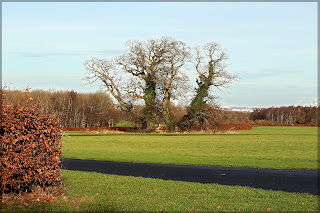 |
| Cycle track |
 |
| Exercise equipment is available near the St Johns Wood and Greenisle entrances |
 |
| Birch woodland |
Prior to the 19th century much of Corkagh would have been covered in trees. Wood was a valuable crop at that time! The Finlay family planted many wonderful specimen trees in the early 19th century including Corkaghs tallest: a Sequoia.
 |
| Corkaghs Sequoia is nicknamed 'Big Red'. It is also known as the 'Boxing Tree': the softness of the bark makes it painless to punch!! |
In front of the estate buildings the Council have created a stunning rose garden which is a favourite spot for park regulars to relax. At one time this would have formed part of the large drive in front of Corkagh House and later, in the 19th century, there were tennis courts here.
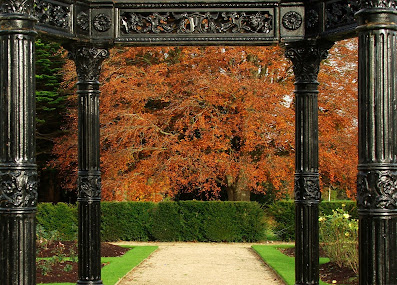 |
| Gazebo at the rose garden |
 |
| Swans over the Fishing Lakes |
The four lakes are among the parks most notable features and while they may appear to have been there forever they were only created in 2001 as part of flood prevention works on the Camac
. The two fishing lakes near the Grange Castle Road entrance were stocked with Carp and Rainbow trout but are no longer actively managed.
. The two fishing lakes near the Grange Castle Road entrance were stocked with Carp and Rainbow trout but are no longer actively managed.
A further two lakes and a wetland area can be found near the rear of the playground. A modern bridge lends its name to the 'Blue Bridge' lake and leads towards the easternmost lake sometimes known as Swan Lake. When Swan lake was being created a medieval enclosure and burial site were discovered. Twenty burials thought to be over 1200 years old were uncovered and removed. Geotextile was laid to protect any remaining burials and the site was backfilled. The curvilinear shape of the enclosure is still echoed in the shape of the hedge and ditch at the eastern side of the field.
 |
| Circular ditch near swan lake |
Crossing the Camac via a pretty bridge you will see what remains of the Stewart's house and Walled garden which date from the first half of the 19th century. The Stewart was responsible for the running of Corkagh Estate. The garden provided fruit and vegetables for the 'big house'! The high walls that surrounded the garden and the lines of Yew and Beech hedges (traces of which can still be seen) afforded protection from the elements thus leading to a 'micro-climate' which allowed for a greater variety of fruit and vegetables. From the 1950s to the 1970s the Karstal family rented the house and gardens. They were famous for the quality of the flowers grown here which they sold at the Dublin Markets. The house burned down in the late 70s but the family remained in the locality.
 |
| Beech avenue at the Walled Garden |
 |
| Path towards the walled garden |
 |
Corkagh has several streams and springs crossed by charming little bridges dating back to the early 1800s. |
The Back Avenue is a tree lined path from the St Johns car park to the fishing lakes. This was the road used by tradesmen and estate employees. In the 1940s Corkaghs owner Dudley Colley (he had married in to the Finlay family) established
Clondalkin Dairies which operated from the estate buildings (now the Council depot) and this road would have been busy with milk vans, featuring the 'Connie the Corkagh Cow' logo,
delivering to local shops.
On the North-eastern side of the park is the pedestrian entrance from Cherrywood. Here you will find the remains of the 19th century Fairview Oil Mills. Indeed records indicate that there has been a mill at this location for centuries. The buildings are now in a ruinous state and there is no access to the public.
You can walk through parkland from Corkagh to Clondalkin village crossing the Fonthill Road South at pedestrian lights. Once you cross the road you are out of Corkagh Park and into Clondalkin Park! There is plenty of interest to see along this lovely walk with the striking Round Tower rising in the distance.
Corkagh has a wide range of habitats and so is home to a large variety of Flora and Fauna. Using an app like Plantnet and Merlin Bird ID to identify the many species of plants and birds at the park reveals the extent of Corkaghs biodiversity. Google lens is excellent for helping ID the stunning dragonflies and butterflies that can be found throughout the park.
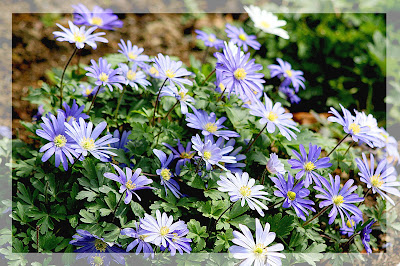 |
| Some of Corkaghs flowers are 'garden escapes' that are now spreading throughout the park like these lovely Greek Anemones. |
 |
| Visitors to the park may notice several raised grassy areas like this one. These were created with the soil that came from the newly dug lakes. |
There are entrances with parking at:
Naas Road (N7) at the Green Isle Road.
R136 (Grange Castle Road).
St Johns Wood
Exercise equipment is available near the Naas Road and St Johns Wood carparks.
There are additional pedestrian entrances at:
St Johns Wood
Cherrywood Crescent
Cherrywood Grove
Corkagh View
Fonthill Rd South.
On the Green Isle Road you can find the attractive and well run Camac Valley Caravan and Camping Park, and from here you will have a wonderful view north over the park.
As you walk around the Corkagh you may notice small wooden signs marking the Maths Eyes Adventure trail. There is a link below which will bring you to their site.
360 degree photos of Corkagh











